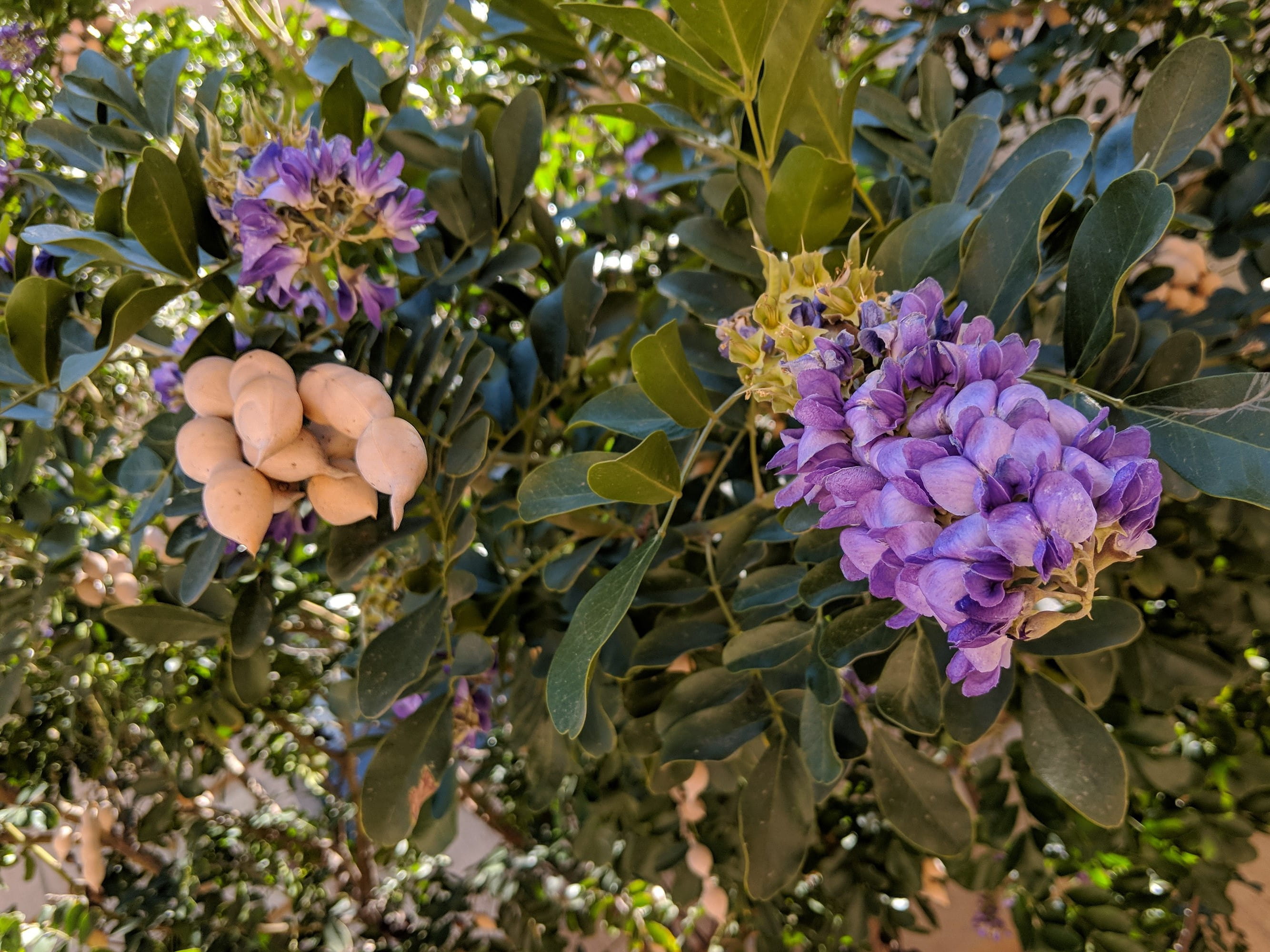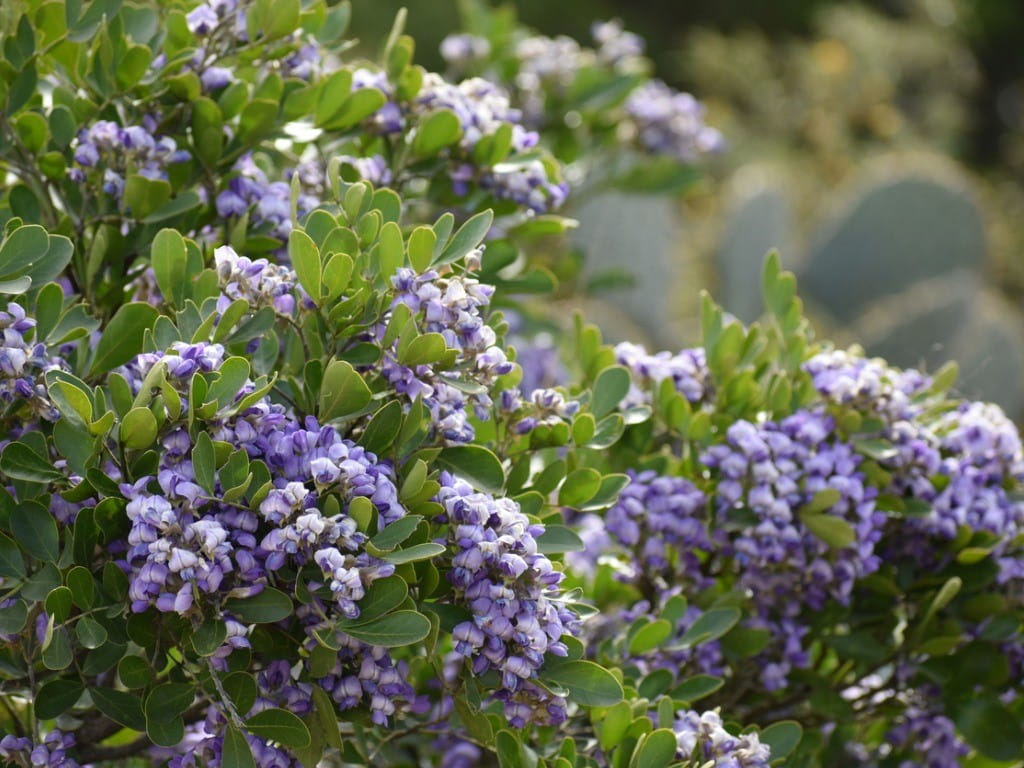Mescal Bean Toxicity

The Bottom Line
Mescal beans grow inside the pale pods of the mountain laurel tree. Mescal beans have been used for ceremonial purposes, but they are not chemically related to the similar sounding hallucinogen mescaline found in peyote. A taste of a mescal bean should not be toxic, but intentional ingestions by people seeking “alternative” ways of getting high can be dangerous.

The Full Story
If you have ever sprouted a plant from seed and you observed two little leaves emerged from the seed—that was a dicot. The Texas mountain laurel (Sophora speciose) is a dicot in the same genetic family as the pea plant. Just like peas, the Texas mountain laurel tree produces pods containing seeds, and these are known as mescal beans. However, unlike peas these are not edible. The plants of the genus Sophora are commonly called “necklace pods” for their long pods that hang as they grow and somewhat resemble an unclasped beaded necklace. Mescal beans are actually used to make jewelry. The beans come in different shades of bright reds to yellows. Like most beans, when they are dried they are hard and last a long time before they start to rot.
The Texas mountain laurel is native to southwest North America. Native American tribes have used mescal beans during ceremonies and have reported hallucinations. Other ritual components may have contributed to developing hallucinations, such as fasting, physical exertion, and lack of sleep.
Mescal beans by themselves can cause hallucinations, but these are accompanied by many other undesirable side effects such as hours of severe vomiting, abdominal pain, low blood pressure, rapid heart rate, confusion, agitation, and tremors. Poisoning with mescal beans is similar to nicotine poisoning because the cytisine compound in mescal beans works on the same receptors that nicotine does. Because of the activity at nicotine receptors, cytisine found in mescal beans has been used for smoking cessation. Despite the similarity in name, mescal beans do not contain mescaline, which is a hallucinogenic alkaloid found in certain species of cactus.
Mescal beans are easy to obtain without restriction. The desired effect of hallucination is not likely to occur without unwanted toxic effects that could lead to hospitalization.
If someone has tasted or eaten a mescal bean, log onto the webPOISONCONTROL® online tool for guidance or call Poison Control at 1-800-222-1222. Whether you log on or call, expert assistance is available 24 hours a day.
Pela Soto, PharmD, BSHS Pharmacogenomics, BS Microbiology
Certified Specialist in Poison Information
Poisoned?
Call 1-800-222-1222 or
Prevention Tips
- Monitor children around plants that have attractive berries or beans.
- Do not taste plants without properly identifying them first.
- Adolescents will often seek "alternative" ways of getting high that are accessible without age restrictions.
This Really Happened
A 20-year-old man was arrested by police. He became agitated and mumbled that he took mescaline, and the police found red beans in his possession. He was taken to an ER where he was found to be sweaty, with dilated pupils, a rapid heart rate (130/min), moderate blood pressure (150/88 mmHg), and temperature of 100.4° F. He was intermittently agitated and at times only responded with single words.
He was treated with medication to calm him down. As his mental status began to improve, he told the ER team that he had actually taken an undisclosed number of mescal beans; he had read online that they could make you hallucinate. His laboratory tests results were all within normal limits. No further toxicity was reported (from Wiegard & Smollin, 2007).
For More Information
Weiser K. Native American rituals and ceremonies. Legends of America [cited 2021 May 30].
References
Hatfield GM, Valdes LJ, Keller WJ, Merrill WL, Jones VH. An investigation of Sophora secundiflora seeds (Mescalbeans). Lloydia. 1977 Jul-Aug;40(4):374–83.
Wiegand TJ, Smollin CG. Ingestion of mescal beans (Sophora secundiflora) causing agitation in an adolescent - a new intoxicant [abstract]. Clin ToxicolPoisoned?
Call 1-800-222-1222 or
Prevention Tips
- Monitor children around plants that have attractive berries or beans.
- Do not taste plants without properly identifying them first.
- Adolescents will often seek "alternative" ways of getting high that are accessible without age restrictions.
This Really Happened
A 20-year-old man was arrested by police. He became agitated and mumbled that he took mescaline, and the police found red beans in his possession. He was taken to an ER where he was found to be sweaty, with dilated pupils, a rapid heart rate (130/min), moderate blood pressure (150/88 mmHg), and temperature of 100.4° F. He was intermittently agitated and at times only responded with single words.
He was treated with medication to calm him down. As his mental status began to improve, he told the ER team that he had actually taken an undisclosed number of mescal beans; he had read online that they could make you hallucinate. His laboratory tests results were all within normal limits. No further toxicity was reported (from Wiegard & Smollin, 2007).
